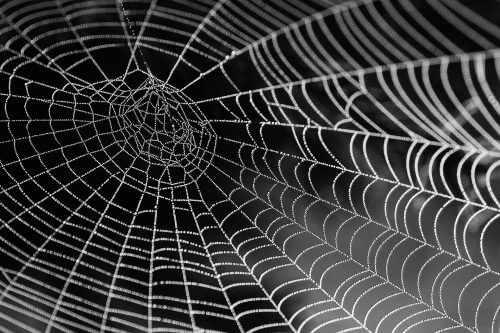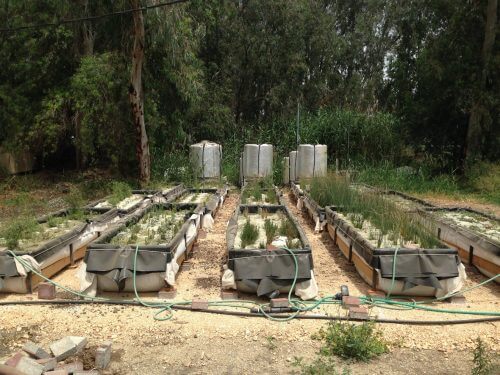Nature is identified as a knowledge base for sustainable technological solutions in the core environmental fields: material, water and energy technologies. Biomimetics, the imitation of nature's solutions, is a growing field of thought in the academic and industrial world, and is recognized as an engine for environmental innovation. In this news we will review two promising biomimetic technologies currently being developed in Israel.
By Yael Halfman Cohen[1], Shlomzion Shen[2], and Ezra Orlovsky[3]

Spider web imitation
The spider's web is a fascinating material that has gained the attention of man in the last thousands of years. Over the past few decades, scientists have learned to understand the inherent potential of using spider webs for the benefit of humanity, taking advantage of their extraordinary mechanical properties. Unlike the captive silk weaver caterpillar and its cocoon cocoons produce normal silk in commercial quantities, the spider is a territorial animal, and its mass breeding for the purpose of producing a commercial quantity of cobwebs is not possible. Therefore, finding a solution that bypasses the need for the spider itself to create spider webs will pave the way for the mass production of these special fibers, and will allow their integration in various applications.
The spider that weaves the web knows how to create different fibers that differ in their properties. The strongest fiber she knows how to weave is called dragline, and it is used by her for the radial fibers in the net, for the net frame and even as an escape fiber. This fiber, natural or artificial, is considered the strongest fiber available. An illustration of the fiber's strength is the fact that it is six times stronger than a steel fiber of equivalent thickness, and significantly lighter than it.
During the last two decades, a large number of attempts have been made to artificially synthesize the proteins that make up the dragline fiber in different protein expression systems - in yeast, bacteria, plants and even transgenic goats. These experiments were made possible thanks to the advancement of the technology used for genetic engineering. Despite this, the fibers that were able to be woven by artificial means are significantly inferior in their properties compared to the natural dragline fiber.
Civics Material Sciences, an Israeli company located in Jerusalem, succeeded in producing fibers that are identical in properties to the spider's cold fiber. In the biological system and production processes developed by the company, it is the first in the world to produce spider web fibers with high frequency and in commercial quantities. Its extraordinary properties - strength, elasticity, durability and low weight - allow the company to develop a wide range of high-end luxury products in various industries, such as the automotive, aviation, defense and sports industries, which require strong and light materials. Fiber is also in demand in the medical device industry due to the fact that it is a biopolymer with a preferred biocompatibility profile. Civics has collaborations with market leading companies to develop the next generation of products.
Imitation of biological desalination

Desalination processes occur in nature in saline plants. An understanding of the desalination process can bring closer the era of natural desalination, which does not involve the investment of energy and chemical substances, and has few by-products. There are three main mechanisms for dealing with excess salt in nature - separation at the source (mangrove), secretion through the leaves (eschel, salty) and storage in fleshy leaves (chain [Sarcocornia sp.], fleshy Ben-Tion [Limbarda crithmoides], Ochem [Suaeda sp.]).
At Miguel, the storage mechanism in the leaves of a variety of Eretz-Israeli saline plants is currently being investigated in the desalination of industrial-agricultural wastewater. The halophytes (plants that survive well in salt concentrations of 300 millimolar or 8,600 mg per liter) were collected from various places in the country where salt concentrations are quite high, such as the salt ponds in Atlit where salt from the sea is dried, and the Dead Sea region. Preliminary results show that these plants store salt in the leaves according to the salt concentrations found in their environment, and that the salt concentration in the leaves can reach 5% of the fresh weight of the plant. This storage capacity is applied in an experimental facility for the local treatment of dairy effluents characterized by high sodium concentrations (see figure). At the current stage there is still use in nature, that is, the salt plants themselves. In the future, after the principles of desalination are understood, we may be able to build a biomimetic technological system that functions in a similar way. The research is funded by the European Union as part of Horizon 2020: Brigade - bridging research and technology to deal with climate change.
The environmental benefits of these technologies are clear. Steel is currently produced in energy-intensive production processes that involve heating to high temperatures and polluting the environment. The development of a fiber that mimics the properties of spider cold will ensure not only a stronger and more flexible material than steel, but also a more sustainable material, whose properties are a derivative of structure and not of energy-intensive production processes. Even the desalination processes that exist today involve a significant investment of energy. The closer we get in the functioning of the desalination systems to the functioning of natural systems, the more energy efficient and sustainable solutions we will have.
Both technologies were presented at the third conference on biomimicry - academia and industry, which took place at Tel Aviv University on June 8.6.2017, XNUMX.
Comments
[1] The Israeli Biomimicry Organization
[2] Civics Material Sciences
[3] Galil Knowledge Center (Migal)

8 תגובות
OK, I understand you Kapish and Akrimska - you are not capable of making a mistake, everyone makes mistakes and the silk weaver is not cultivated and lives in the wild.
And the Chinese billions go to the field and collect his cocoons from the field to make silk for the Japanese...
Wikipedia is wrong, all the encyclopedias are wrong, the textbooks and my teacher in high school (who gave us a silk thread to grow at home as a biology project) was wrong, Amir Weinstein's website is wrong (link attached), and everyone is wrong, only the gatekeeper saw the silk thread in the mulberry trees in his garden..
a quote :
"The silkworm Bombyx mori belongs to the family of the silkworm Bombycidae which includes about 300 species and is common in South and East Asia. In Israel, the family does not have a single representative in the bar. The silk weaver is the familiar representative of the family. The cultivated strain* was developed from a wild species originating in East Asia and its full identity is not entirely clear, the closest wild species today is Bombyx mandarina. Unlike the wild species, the cultivated species cannot survive without human help since the adults (both pairs) are flightless. In the wild species only the female does not fly and the male does. Males are attracted and fly to females following a sex pheromone that the female releases into the air. "
http://www.insectour.com/Web/?PageType=0&ItemID=283567
now I get it . You "draw" information from Wikipedia and are convinced of its reliability
Oh well ,
to the point
Domestication is changing morphological, behavioral and other characteristics by selection over time,
to suit the requirements of the host,
So with chickens, cows, horses, dogs and more,
If people grow diarrhea to make compost,
They keep wild animals in circuses or zoos, raise turtles in the garden
Or cypresses and tilapias in ponds is not domestication,
The same goes for fur animals or alligator breeding,
Contrary to "Wikipedia", the Silk Route exists in the bar and is visible, growing and developing
Just like the "domesticated" caterpillar, which is not domesticated,
Capish?
For the gatekeeper:
Here you will find more reliable material than the Hebrew version:
https://en.wikipedia.org/wiki/Bombyx_mori
Correction - one of the first emperors in China. (not the tsar, that tsar was in Russia)
It's true that I made a terrible tactical mistake when I wrote "as I know" this is an omission that shows a lack of confidence and should not be written here in this way.
In short - in Hebrew Wikipedia it says "collections" - this is probably the source of your mistake and it is not true.
Cows also graze in the meadow and then they are collected and slaughtered.
Nevertheless, the cows that are in the meadow today are not the same cows that grazed in the Philaeolithic period.
The silkworm was discovered in China during the time of the first tsars more than a thousand years ago and since then it cannot be found in the wild anywhere in the world.
The silkworms are raised in protected habitats on mulberry leaves in special cages, the leaves are changed for them like the straw is changed for the cows in the barn.
These butterflies are completely helpless, they are not even able to fly more than a few centimeters and do not survive on a mulberry tree outside longer than it takes any common bird to eat them.
Avi ,
You started in "As I Know"
It turns out that what you know is not true,
The caterpillar grows in the wild on mulberry trees and what the silk farmers do
It's growing strawberry trees and collecting tubers,
It's like children picking chameleons, natives collecting coconut larvae,
Yemenis collect locusts and so on
Stiff?
As I know the silkworm butterfly is not able to exist in nature except artificially without treatment.
He is like many farm animals that are unable to live in the wild without the person who takes care of them, he has undergone changes as a result of artificial selection over hundreds or thousands of years.
So yes, you can say about him that he is domesticated like you can say that about the chicken.
It would have been better if the writers had been careful and precise, yes
Unlike what is written, a silk caterpillar was never "domesticated" but simply collected,
Like the termites in Africa or the locust and other insects around the world.
"Synthesis" in Hebrew combination.
The strength of a fiber is not "parallel" but equal...
- Salt plants also expend energy to separate water from salt...